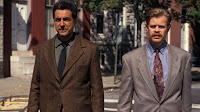
Antichrist (2009)
Directed by Lars von Trier
Starring Charlotte Gainsbourg, Willem Dafoe
Director von Trier wants you to not simply be unsettled, but he wants you to be in a place where you are completely uncomfortable. Once he has you in that place he can begin to burrow under your skin and really get to work. The opening sequence of his latest opus, Antichrist is designed to do just that. The soundtrack is blaring, the images are stark and...um, yes that is actual penetration you're seeing. And that heavily jarring scene is key to understanding what von Trier is trying to do in this film.
The plot concerns an unnamed couple (Gainsbourg and Dafoe) who are in the midst of orgasm when their toddler son falls out the window of their apartment to his death. Off screen, the wife spends time in a mental hospital and her husband wants to help her work through her grief. His motives are a bit suspect; does he truly want to help her or does he simply not want to be reminded of his own guilt? His desperate need to heal her leads them to their secluded cabin in the woods, nicknamed Eden.
Von Trier is playing his traditional game of taking a genre and twisting it around into something that suits his own aesthetics. The horror in the film is slow burning and abstract and, when the gore does occur, it is much harsher than American audiences are used to. I was reminded of Michael Haenke's Funny Games (especially the American remake)in how it was intentional designed to play out slowly and then completely exceed the expectations of violence in the audience. Von Trier is setting out not only to antagonize an audience wanting to be spoon fed horror tropes but also to offend the film "elite" he see saws back and forth with as "darling" and "dismissed".
The core of the film is less supernatural and more metaphorical. It's intentional that the couple are never named and end up in a Grimm-like forest complete with talking animals. While superficially it is about one husband's total lack of respect for his wife as an adult individual. On a larger stage it saying a lot about sexuality, guilt we associate with our children, and humanity's relation to the world around it. Definitely not a film for the faint of heart but containing much more beyond the fervor surrounding it.






